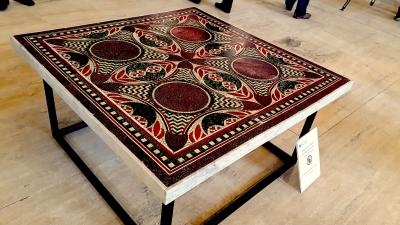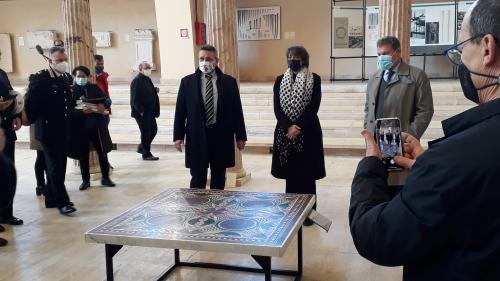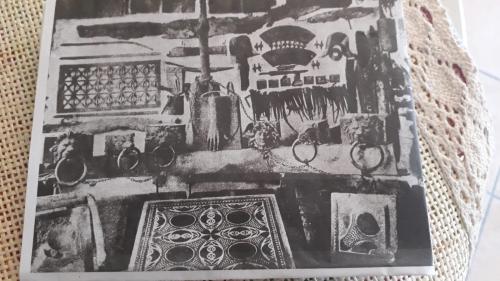Caligula Memento comes home to Nemi

ROME - Nemi, a small town in the Alban Hills 27 kilometres from Rome, has scored a recent double coup with the return of a rare antiquity, blazoned in the international press, as well as the announcement of a Euro 250,000 grant from the EU through the Lazio Regional government to spruce up Nemi's archaeological attractions.
So Alberto Bertucci, Nemi's mayor, had good reason to express all his satisfaction during the presentation of the piece of inlaid marble pavement that came from one of the Roman ships recovered from the bed of Lake Nemi in the 1930s. The well preserved 1.5 sq. metre fragment with an intricate geometric inlay pattern of precious red and green porphyry, serpentine and moulded glass, had been lost without trace for over half a century. It was discovered in New York almost by chance in 2013 by a keen-eyed art historian, who recognized it in a photograph shown during a book presentation. The Italian authorities were informed and the lengthy process of seizure and extradition began that culminated in the recent official presentation of the colourful opus sectile panel in the Roman Ship Museum at Nemi lakeside.
“This is a great day for Nemi and our entire territory!” Mayor Bertucci enthused.
The precious piece of deck decoration and the history of its recovery was hailed as a rare triumph for the museum, which lost not only its main exhibits - the two colossal ships built by the Roman emperor Caligula, destroyed during WWII – but also the bronze sculptures and embellishments that were on board and which are now part of the collection of the National Museum of Rome Palazzo Massimo.
The official presentation of the mosaic at the Museum of the Roman Ships on the shore of lake Nemi was attended in person by Massimo Osanna, former director of Pompeii and now General Director of the Museums of Lazio, along with representatives of Italy's crack investigative squad, the Reparto Operativo Carabiniere Tutela Patrimonio Culturale (Operative Department of the Carabiniere for the protection of the country's cultural heritage), constituted in 1969 and specialized in tracking down Italian art and antiquities smuggled out of the country and sold illegally. Success stories have included headline-scoring operations like the spectacular recoveries of Roman and Etruscan artefacts and sculptures, such as the Euphonious Krater, from the Metropolitan Museum of Art NY in 2006 and the Morgantina Venus, restituted by the Getty Museum in 2011. In both cases investigators were able to prove that the acquisitions had been irregular.
Osanna said that the mosaic panel was a particularly fine example of Roman decorative art and showed that Caligula had spared no expense in fitting out the two enormous boats.
“History records the existence of floating palace like the celebrated one used by Antony and Cleopatra when they cruised down the Nile. It was probably this model that Caligula wanted to imitate,” he commented.
The sumptuously decorated vessels were sunk in the lake after his death, as part of the Damnatio Memoriae process (the obliteration of all memories and connections, reserved for unpopular rulers) and historians are still undecided whether the vessels were used by the Emperor simply as a summer retreat or whether they were connected with the cult of the goddess Diana, who had an important sanctuary on the lake side.
The saga of the recovery of the Nemi mosaic is typical of thousands of Italy's art treasures and antiquities that vanished during the second half of the 20th century. Except in the case of a major objet d'art, most successful operations go largely unnoticed by the general public. This time, however, the account received ample coverage in the US press, thanks to the quirky twists to the story.
The detective work involved in tracking down many stolen or misplaced works can inevitably be lengthy and laborious. The case of the Nemi panel, however, came about by a lucky chance. It had been documented when it was first recovered from the bottom of Lake Nemi during the first archaeological campaign in 1895, commissioned by Prince Orsini, the then overlord of Nemi and was photographed along with the cache of other recuperated artefacts and artistic objects. The photograph was published in the 1940 book “Le Navi di Nemi”, a seminal study of the titanic recovery operation of the two Roman ships in the 1930s that involved draining off the lake water through a 4th century BC channel tunnelled through the surrounding hillside that was re-opened especially for the operation.
However, sometime during the post-war years, the intarsia panel vanished, apparently without trace. Inexplicably, it was to turn up in New York many years later in the home of Helen and Nereo Fioretti, a couple of Manhattan gallery owners and antique dealers, who converted it into a coffee table top and had kept it, openly displayed in their sitting-room, apparently unaware of its origins, for over forty years..
The discovery came out of the blue in 2013 when architect Dario Del Bufalo, an expert on ancient marbles, was presenting his book: “Red Imperial Porphyry. Power and Religion” to an audience of art historians and dealers in New York. A picture of the Nemi mosaic appeared in the book and friends of the Fioratti couple recognized it.
An investigation duly followed. Ms. Fioratti claimed that she and her husband had bought the item years earlier “in perfectly good faith” from an unidentified Italian aristocrat and had had no idea what it was or that it had been illegally exported. In the end no charges were brought against them. The piece was legally sequestered by the American authorities who eventually turned it over to the Italian Consulate General in Manhattan in 2017, where it was laid out in triumphal display on top of the Italian flag.
Formalities dragged on till finally, seven years later, Italy managed to bring the trophy home, where it was restored and cleaned of the traces of coffee stains it had acquired in the Fioretti Park Avenue apartment.
“In spite of Covid restrictions, we decided to put the mosaic on show now because we felt there had been enough procrastinating!” explained Osanna.
Back finally in home base, the artefact now has a prominent position in the museum, matched with two small broken fragments of identical design that were already in the museum's possession. Nearby stand the 1.5 scale models of the original ships, replicas fortunately constructed before the war in the shipyards of the Ministry of Defence at Castellammare di Stabia
The publicity generated by the recovery of the mosaic is expected to attract large numbers of visitors once pandemic restrictions ease, Bertucci said. Nemi relys heavily on tourism and has suffered badly during the lockdown and semi-lockdown periods. In 2020 the 87th Strawberry Festival, which is the town's main event of the year, attracting crowds of thousands, had to be presented solely in virtual form and it is still unclear if this year's edition will be able to go ahead live.
Plans, however, have been announced to carry out necessary restoration work on the Roman Ship Museum, which is a landmark example of modern architecture, designed by Vittorio Ballio Morpurgo, one of Italy's foremost architects of the Fascist period, and one of the first examples in the world of a museum designed specifically around the exhibits it displayed.
The Euro 250K grant is aimed instead at cleaning up the overgrown and sadly neglected ruins of the Temple of Diana, which are situated a short walk along the lakeside from the museum. Once one of the most important religious centres of the Roman world, the sanctuary has been partially excavated during different archaeological campaigns from the late 19th century onwards and just as regularly closed up and abandoned.
Until now, the museum and the temple site have been managed as two separate entities. Osanna said that he hopes to see the sanctuary finally linked to the museum, making one united archaeological site open to the public.
ms




